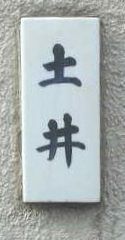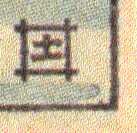|
The Doi Publishing House Seals
Teiichi Doi (died 1945) opened his woodblock print publishing
business in 1930 in Tokyo, having at that time just returned from San Francisco where he had been
an art dealer of Japanese "shin-hanga" prints for the two previous decades. It is no doubt that his experiences in America as a dealer lead him later to his great success as a publisher. Artists whose works were published
by Doi were among others Hasui, Koitsu and the French artist Nouet. After
Teiichi's death in 1945 his son Eiichi (1917-96) took over the family business, which is
still nowadays run by Eiichi's widow and their daughter from their business near
Tokyo.
|

|
|
|
"Doi" - the
nameplate at the
present Doi residence
|
In principle, we can distinguish between pre-war Doi editions and post-war
Doi editions. Exact dating however is not always
possible, because the Doi publishing house appearantly did not always follow strict principles
in sealing.
Dark background indicates PRE-war
seals, bright background POST-war seals.
Please note, many Doi seals are
very similar and one needs a close look to figure out the differences. The "Doi
Teiichi" and
"Doi Eiichi"
seals both have four characters
in the seal, of which ONLY the third character from top is
different. The
"Doi Hangaten"
publisher's seal however comprises
five characters in it's left half, a simple fact, which assists the identification.
|
A
|
1931 - ?
|
The upper part (right side/left side/up-down reads
"hanken shoju" - Copyright Reserved), the lower four characters read
"Doi Teiichi." Doi is the family name, the first name "Teiichi" can
also be pronounced "Sadaichi". Note--this seal is not "framed" compared
to all later seals.
|
|
B
|
1931 - ?
|
Rare early "Doi Teiichi" seal with separate printer/carver information in a
second lower box. On top of the name "Doi Teiichi" we
find the four characters "hanken shoju" in a square arrangement.
|
|
C
|
1933 - 1945
|
"Triple offset boxes" arrangement. Left side, upper
box reads "Doi Teiichi", right side "hanken shoju". Lower box left side
is carver Ikeda, right side printer Yokoi.
|
|
D
|
approx. 1946 - 1955
|
Upper box reads left side"Doi Hangaten",
right side "hanken shoju". The center box mentions the printer Itoh,
the lower
box the carver Ikeda. It is estimated, that this seal type got used just
after the war with the original blocks until approximately the mid-1950's, but there is
still some continuing debate whether this seal type could be pre-war.
|
|
E
|
approx. **1956 - 1962
|
"Doi Hangaten", same "triple offset boxes" arrangement
as with the "C" seal.
Almost all prints of the "E" type show the combination Harada (carver) and Yokoi
(printer), indicating that the original blocks were recut by Harada. Other prints
of "Doi Hangaten" show Itoh as printer, however, no further
printers are known to the author in this seal combination.
**UPDATES (January 2004 and June 2005) Recent research conducted by Marc Kahn now indicates a strong likelihood that this
"E" seal
("Doi Hangaten/Harada/Yokoi" seal combination) may well have been used on PRE-War Doi-published prints during the period
of 1936/38 to 1956 and onward to 1962. (For further comments, see UPDATES below.)
|
|
F
|
1963-1981
|
Published by "Hamamatsudo".
This seal, in the shown wide version as well as in slim versions was used for
Doi prints in the period 1963-1981. "Hamamatsudo" was run by Mrs. Doi's brother. These prints bear the
carver Harada and printer Seki names.
|
|
G
|
?
|
This "Doi Eiichi"
seal is very rare. A precise timing is difficult, most probably around 1980-1990.
The lower offset boxes mention carver Harada (left) and printer Seki
(right).
|
|
H
|
1981-
|
This
"Doi Eiichi" seal is now very common for late editions of Hasui and Koitsu, it
gets applied continuosly since approximately 1981, but a few earlier exceptions may
exist. It reads left Doi Eiichi, right "hanken shoju" - Copyright
Reserved.
|
Detailed dating for the
"H" seal prints:
|

|

|

|

|
|
approx. 1970-75
|
1970-1980?
|
1981-1995
|
1996-present
|
|
carver Endoh
printer Matsuzaki
|
carver Endoh
printer Itoh
|
carver Harada
printer Seki
|
carver Harada
printer Hamano
|
A further detailed explanation of Doi printer and carver seals can
be found in the "Doi section" at www.shinhanga.net.
Doi's Three "Primary Printers"
|

|

|

|
Although many printers have worked
for the Doi publishing house especially in the pre-war era, there are only three
printers whom we can call the Doi "primary
printers," because each of them worked or still works for Doi for an extended period of time.
|
|
Yokoi
|
Seki
|
Hamano
|
Note: the top character reads "suri" = printer
|
Doi's earliest "primary printer" was Yokoi (YOKOI, Giichi; 1894-c1980)
who produced prints continuously for
Doi from the period of about 1936 to 1965. His early printings during the
late 1930's of various images by artist Koitsu
were so superb that he was then apparently promoted to be Doi's "principal
printer," a position which he maintained
until
his retirement from Doi in 1965.
Doi's second "primary printer" then became Seki (SEKI, Kenji; 1940- )
who when at the age of 15 came to
Doi in 1955 and began a TEN-year apprenticeship under the watchful supervision
of his "sensei," Yokoi.
Beginning in 1965 (Yokoi's retirement) his "Seki seal" first began
to appear on prints, when he became Doi's second
"primary printer" from the period 1965 to 1995. Seki is still today active in the Tokyo area.
Doi's third "primary printer" is now Hamano (HAMANO, Masayoshi:
c1950- ) who studied under
Komatsu Heihachi (printer for the Yoshida Hanga Studio c1970-80's) in the
1970's. He has been working as "primary
printer" for Doi continuously since 1995 until the present time.
Further Doi seals
|
I
|
This small seal "Do"-character
in a box shape (an "I"-shaped character) is found on Doi "postcard prints."
|
|
J
|
"Hanmoto
Tokyo Do" (a "Doi affiliate"). Not much is known about this seal, probably it got used in pre-war
times on Koitsu prints.
|
|
K
|
"Oeda
Mokuhansha" (a "Doi affiliate"). This Tokyo based company published during 1984-1990 several Hasui,
Nouet
and Koitsu prints.
|
UPDATE (January 2004 and June 2005)
As mentioned above under comments for "E" seal, recent study and analysis conducted by Marc Kahn (using data by Tosh Doi--no
relationship to Doi Publisher); now indicates a strong likelihood that the
"Doi Hangaten/Harada/Yokoi" seal combination may well have been used on PRE-War Doi-published prints during the period
of 1936/38 to 1956 and onward to 1962. A compelling argument in support of this earlier dating is presented in full at Mark Kahn's
Shotei.com website, in an article he's titled
"Dating Prints Marked 'Doi Hangaten.'"
Finally, a piece of hard evidence which supports the argument that "Doi Hangaen" marked prints may certainly date to
the PRE-War period of 1936/38 (as suggested above) comes to us from the "cover page" of a 24-print portfolio
of Noel Nouet prints (titled "Scenes of Tokyo, Twenty-four Views") published by Doi Publisher in 1937. This
cover page's publisher is given as "Hanmoto Doi Hangaten"--PROOF
positive that the Doi used the word "Hangaten" certainly as early as 1937.
(We again wish to acknowledge the
attentiveness of Marc Kahn, who "gleaned" this tid-bit of information from our own
"The Woodblock Prints of Noel Nouet"
article that we ourselves had posted two years ago in April 2003.)
(c) Copyright Andreas Grund and Thomas Crossland; 2002-2005







